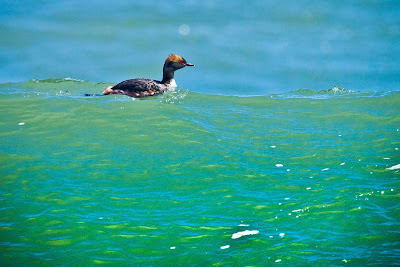The Horned Grebe gets everything he needs from the water.
He’s at home in the water, but awkward on land because his legs
aren’t squarely positioned under his body…rather somewhat behind. That adaptation gives him great speed
for catching fish, but makes walking on land difficult. Some species of grebes
can’t walk on land at all.
Despite the inability to navigate well on land, for a
bird that eats, sleeps and rears young on floating mats of vegetation, his flying
and swimming skills alone are more than adequate to get him around.
Plucking flies, beetles and spiders from the water’s
surface is just a snack for him. He excels at fishing.
Tail-chasing a fish, to catch it underwater, is something I'd like to see.
Diving to fish, he rises again a few hundred
feet away. This one was fishing
the waters between the Calatrava Art Museum and Discovery World in
downtown Milwaukee, WI.
April to August is the breeding season for Horned Grebes. They’re in full breeding colors now.
They transform themselves from a basic black and white bird into a new multi-colored version each year. Sporting bright yellow 'horns' behind blood red eyes, a rusty-red neck and charcoal back...males and females look alike.
This Horned Grebe was in color transition when I found him riding
the crest of a wave in the Atlantic Ocean in early April.
The Horned Grebe enjoys a unique, sought-after status in the birding world. Reports of a Horned Grebe sighting will bring out all manor of wildlife photographers.
Horned Grebes are not rare in Wisconsin. These are likely just passing through on their way to Canada or Alaska to raise their young.
He will be turning to leave Wisconsin soon, so if you want
to see one in person, now is your time to go looking.
Allan









No comments:
Post a Comment